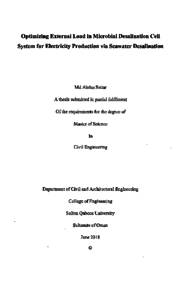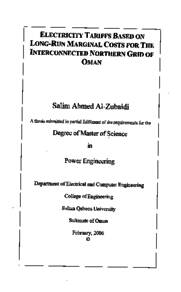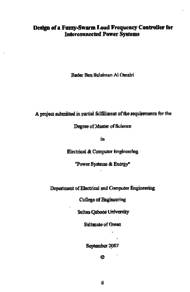Document
Optimizing external load in microbial desalination cell system for electricity production via seawater desalination.
Publisher
Sultan Qaboos University
Gregorian
2018
Language
English
English abstract
The title of the thesis is Optimizing External Load in Microbial Desalination Cell
System for Electricity Production via Seawater Desalination.
In recent years, microbial desalination cell (MDC) has attracted extensive attention
as an emergent ecofriendly and promising technology for direct conversion of
biochemical energy into electrical energy without any intermediate steps. This
cutting-aged technology is capable of treating wastewater and removing salts from
the saline water while generating electric current from organic wastes.
In this study, an MDC that has four chambers was used to investigate the performance bio-electrochemical processes. These processes include the removal of organics, total solid (TS) and salinity with the concurrent production of electrical power and value added chemicals (HCl acid and NaOH base). All the bio electrochemical parameters were investigated with five different external resistances
as 150 12, 100 12, 50 2, 25 22, and 10 2. Moreover, the open circuit voltage,maximum columbic efficiency and power density were optimized to find the best operating resistance for this particular design of MDC reactor. The system operated with 8 hours hydraulic retention time (HRT) for anode, cathode and acid production chamber. But HRT for desalination chamber was 2.7 hours. The MDC produced a steady state cell potential at the end of the microbial inoculation of twenty days.
The maximum produced cell potential was 431.95 mV during inoculation stage with
external resistance 50 2 when activated, digester sludge and whey solution were
mixed with the raw wastewater. The maximum removal of chemical oxygen demand
(COD) and TS were 57.14% and 14.29%, respectively, from the raw sewage. The
maximum increase in substrate conductivity after the treatment of raw sewage was
167 uS/cm using the external resistance 150 S2, while, the maximum decrease in pH
was 1.05 for the external resistance 100 2. The maximum desalination efficiency
and the reduction in conductivity for the seawater were 46.52% and 18.10 mS/cm,
a respectively, at the external resistance 10 2. The maximum pH reduction was 1.15
for the seawater for the external resistance 50 12. The maximum cell potential was
recorded at the external resistance of 150 12 was 586.28 mV. The achieved maximum
electric current, power and columbic efficiency (CE) at an external resistance of 25
cu 12 were 17.59 mA, 7731.68 mW and 58.30%, respectively. The maximum open
circuit (OCV) was found to be 918.00 mV for the operating resistance of 20 22, which showed the best applied resistance for the MDC system. With this best operating resistance, the system produced the maximum power density of 302.25 mW/m2 with substrate loading of 336 mg/l as raw sewage. The performance of the MDC reactor in term of acid and base production was not significant. The pH of phosphate buffering solution increased instead of decreasing. The performances of the investigated MDC system showed a great potential for recovering electrical power with a significant removal of organics from wastewater and salt from seawater.
Member of
Resource URL
Arabic abstract
في الآونة الأخيرة، جذبت خلية التحلية الميكروبية اهتماما واسع النطاق باعتبارها تكنولوجيا صديقة للبيئة وواعدة للتحويل المباشر من الطاقة البيوكيميائية إلى طاقة كهربائية دون أي خطوة وسيطة. هذه التكنولوجيا المتطورة قادرة على معالجة المياه العادمة وإزالة الأملاح من مياه البحر مع توليد تيار كهربائي من النفايات العضوية. السبب المهيمن لجذب الانتباه الكبير للمجتمع العلمي هو أن هذه التكنولوجيا يمكنها أن تؤدي عملها بدون تزويدها بأي طاقة خارجية ، والتي تعتبر خطوة مميزة في العصر الحديث.
في هذه الدراسة، تم استخدام خلية تحلية ميكروبية تحتوي على أربعة غرف لتحليل الأداء الكهروكيميائي الحيوي. حيث تم تقييم إزالة المواد العضوية، والمواد الصلبة الإجمالية والملوحة مع الإنتاج المتزامن من الطاقة الكهربائية والمواد الكيميائية ذات القيمة المضافة (مواد حمض وقاعدية). تم فحص جميع العوامل الكهروكيميائية الحيوية بخمس مقاومات خارجية مختلفة ب 150 9 و 100 و و 50 2 و 25 2 و 10 . علاوة على ذلك، تم تحسين جهد الدائرة المفتوحة والكفاءة الكولومبية القصوى وكثافة الطاقة للعثور على أفضل مقاومة تشغيلية لهذا التصميم الخاص بخلية التحلية الميكروبية، حيث يعمل النظام خلال 8 ساعات من وقت الاحتفاظ الهيدروليكي لغرفة الأنود والكاثود وغرفة إنتاج الحمض، في حين تم استخدام 2 , 7 ساعات لغرفة التحلية بلغ الحد الأقصى المنتج من الخلية 431 . 95 مللي فولت خلال مرحلة التلقيح مع المقاومة الخارجية 50 و عندما تم مزج الحمأة المحفزة والثابتة والمصل الحيوي مع مياه الصرف الصحي، وكان الحد الأقصى لإزالة الطلب على الأوكسجين الكيميائي والمواد الصلبة 57 , 14 % و 14 , 29 ٪ على التوالي من مياه الصرف الصحي. وكانت الزيادة القصوى في الموصلية الكهربائية بعد معالجة مياه الصرف الصحي 167 مللي سيمنس/ سم باستخدام 150 غ كمقاومة خارجية، في حين أن أقصى انخفاض في الرقم الهيدروجيني كان 1 . 05 للمقاومة الخارجية 100 2. وكانت الكفاءة القصوى لتحلية المياه والحد من الموصلية الكهربائية لمياه البحر 46 , 52 % و 18 , 10 مللي سيمنس اسم، على التوالي عند المقاومة الخارجية 10 . وكان الحد الأقصى لخفض درجة الحموضة لمياه البحر 1 . 15 للمقاومة الخارجية 50 22. كما تم تسجيل الحد الأقصى المحتمل للخلية 586 , 28 مللي فولت عند المقاومة الخارجية 150 2. وبلغ الحد الأقصى للتيار الكهربائي والطاقة والكفاءة الكولومبية 17 , 59 مللي أمبير و 7731 . 68 مللي واط و 58 , 30 % على التوالي عند مقاومة خارجية 25 ي. في حين تم العثور على أقصى دائرة مفتوحة لتكون 918 مللي فولت لمقاومة التشغيل 20 22، والتي أظهرت افضل مقاومة تطبيقية لنظام خلية التحلية الميكروبية. وبفضل أفضل مقاومة تشغيلية، أنتج النظام كثافة القدرة القصوى 302 , 25 مللي واط / م2 مع تحميل عضوي قدره 336 ملغم / لتر كمياه صرف صحي. ولم تنتج خلية التحلية الميكروبية كمية تذكر من المواد الحمضية أو القاعدية. في حين ازداد الرقم الهيدروجيني لمحلول الفوسفات المؤقت بدلا من التناقص
في هذه الدراسة، تم استخدام خلية تحلية ميكروبية تحتوي على أربعة غرف لتحليل الأداء الكهروكيميائي الحيوي. حيث تم تقييم إزالة المواد العضوية، والمواد الصلبة الإجمالية والملوحة مع الإنتاج المتزامن من الطاقة الكهربائية والمواد الكيميائية ذات القيمة المضافة (مواد حمض وقاعدية). تم فحص جميع العوامل الكهروكيميائية الحيوية بخمس مقاومات خارجية مختلفة ب 150 9 و 100 و و 50 2 و 25 2 و 10 . علاوة على ذلك، تم تحسين جهد الدائرة المفتوحة والكفاءة الكولومبية القصوى وكثافة الطاقة للعثور على أفضل مقاومة تشغيلية لهذا التصميم الخاص بخلية التحلية الميكروبية، حيث يعمل النظام خلال 8 ساعات من وقت الاحتفاظ الهيدروليكي لغرفة الأنود والكاثود وغرفة إنتاج الحمض، في حين تم استخدام 2 , 7 ساعات لغرفة التحلية بلغ الحد الأقصى المنتج من الخلية 431 . 95 مللي فولت خلال مرحلة التلقيح مع المقاومة الخارجية 50 و عندما تم مزج الحمأة المحفزة والثابتة والمصل الحيوي مع مياه الصرف الصحي، وكان الحد الأقصى لإزالة الطلب على الأوكسجين الكيميائي والمواد الصلبة 57 , 14 % و 14 , 29 ٪ على التوالي من مياه الصرف الصحي. وكانت الزيادة القصوى في الموصلية الكهربائية بعد معالجة مياه الصرف الصحي 167 مللي سيمنس/ سم باستخدام 150 غ كمقاومة خارجية، في حين أن أقصى انخفاض في الرقم الهيدروجيني كان 1 . 05 للمقاومة الخارجية 100 2. وكانت الكفاءة القصوى لتحلية المياه والحد من الموصلية الكهربائية لمياه البحر 46 , 52 % و 18 , 10 مللي سيمنس اسم، على التوالي عند المقاومة الخارجية 10 . وكان الحد الأقصى لخفض درجة الحموضة لمياه البحر 1 . 15 للمقاومة الخارجية 50 22. كما تم تسجيل الحد الأقصى المحتمل للخلية 586 , 28 مللي فولت عند المقاومة الخارجية 150 2. وبلغ الحد الأقصى للتيار الكهربائي والطاقة والكفاءة الكولومبية 17 , 59 مللي أمبير و 7731 . 68 مللي واط و 58 , 30 % على التوالي عند مقاومة خارجية 25 ي. في حين تم العثور على أقصى دائرة مفتوحة لتكون 918 مللي فولت لمقاومة التشغيل 20 22، والتي أظهرت افضل مقاومة تطبيقية لنظام خلية التحلية الميكروبية. وبفضل أفضل مقاومة تشغيلية، أنتج النظام كثافة القدرة القصوى 302 , 25 مللي واط / م2 مع تحميل عضوي قدره 336 ملغم / لتر كمياه صرف صحي. ولم تنتج خلية التحلية الميكروبية كمية تذكر من المواد الحمضية أو القاعدية. في حين ازداد الرقم الهيدروجيني لمحلول الفوسفات المؤقت بدلا من التناقص
Category
Theses and Dissertations



